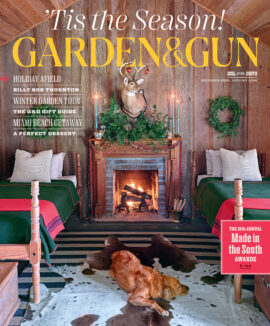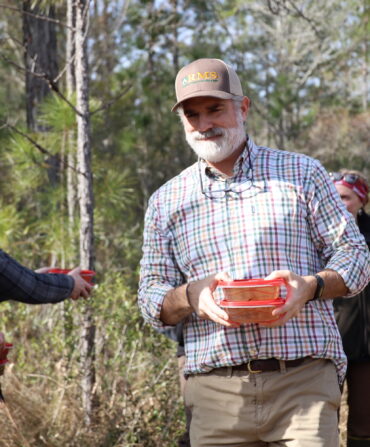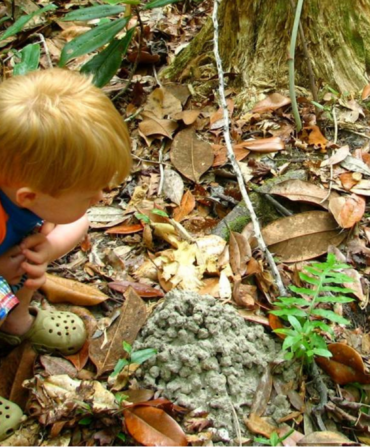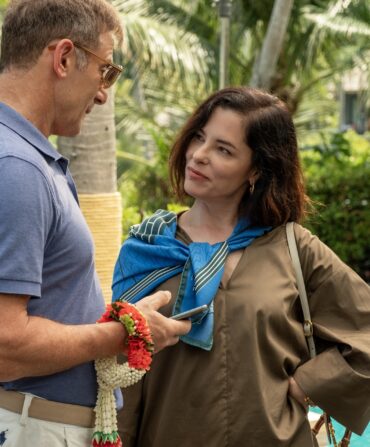Travel
A Stay on Scotland’s River Deveron Brings an Immersion in Wild Browns, Fog-Shrouded Castles, and Stunning Views
For a seasoned group of fish-minded travelers, a bucolic adventure comes with a taste of the royal treatment
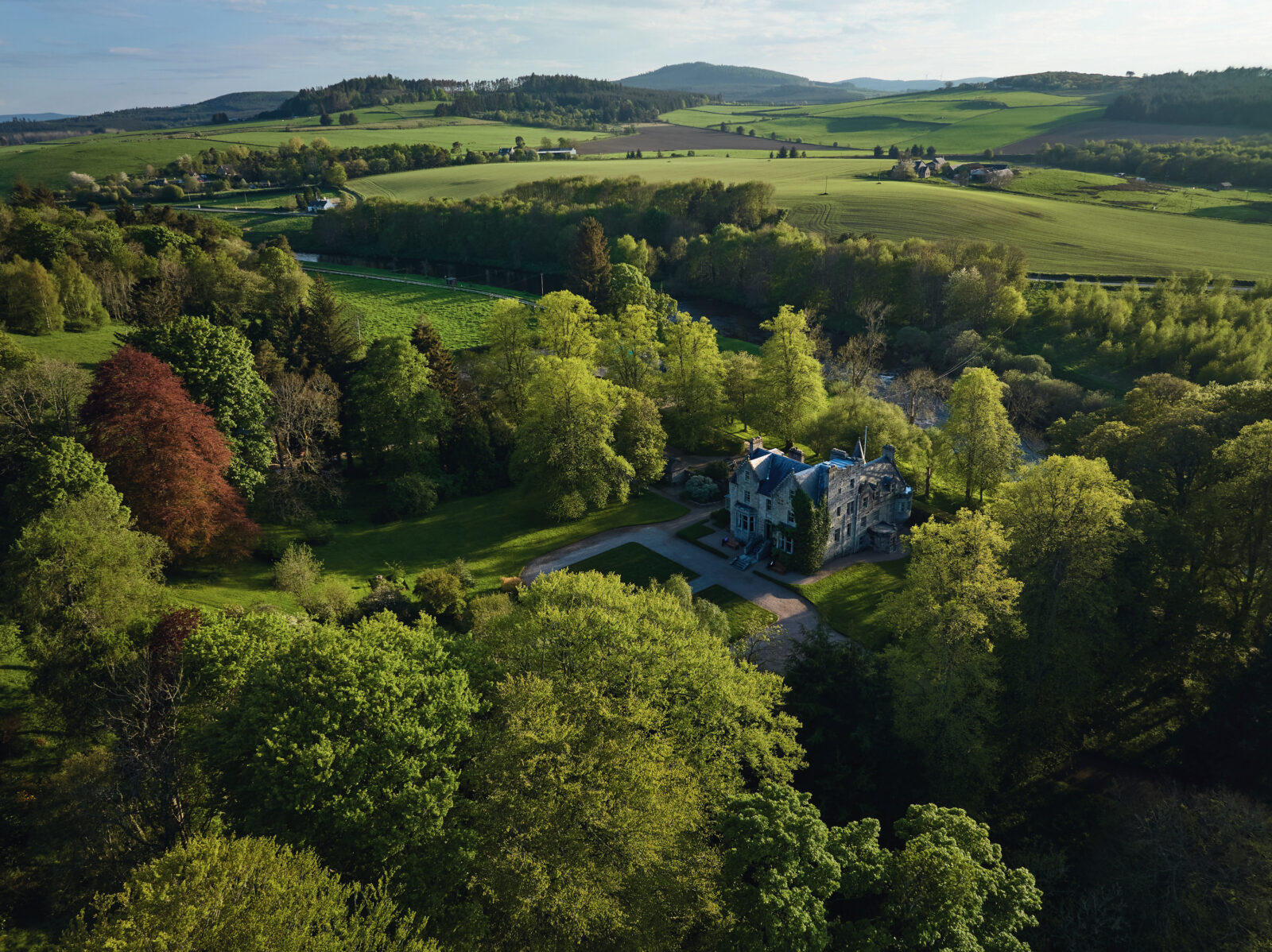
Photo: WILLIAM HEREFORD
Home base at Avochie Estate in Aberdeenshire.
So there we were on the storied River Deveron in the merry month of May, an equally merry band of well-seasoned ladies and gents who over the years have traveled together far and wide in search of piscatorial, cultural, gustatory, and vinous adventures. An A-Team of pura vida angling predators, we were…and after two full days on the river, not one brown trout over sixteen inches among us. And nobody cared. Not one of the people around the long, lavishly appointed dinner table at Avochie Estate’s main house that night so much as mentioned the less than stellar fishing. It would have been like carping that the dill sauce for the perfectly cooked salmon we were served was not quite the thing.
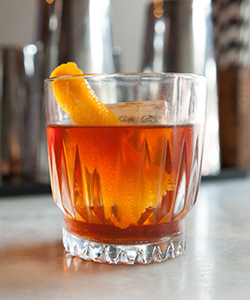
In fact, this group has never mistaken the sauce for the meals, which in our case consist of trips to places like Spain, Slovenia, Argentina, Ireland, Cuba, and Wales that happily pair fly fishing with a bit of this and a bit of that: tours to places of historical and cultural interest for those in our group who do not fish and for some of us who do; the occasional pub crawl or golf outing; and dives into local music, food, and potables. We rarely stay in fishing lodges and never in tents, though the fishing might be better in either. We’ve all done our share of both. Now we prefer to base ourselves at places like Avochie Estate, which sits serenely at the foot of the Grampian Mountains in the northeastern Scotland county of Aberdeenshire—as fine a part of the world as any, we discovered, for our kind of travel.
My friend the sporting outfitter William Daniel had suggested this trip to me while our group was fishing the chalk streams of his native England with him. Knowing my penchant for wild brown trout, he mentioned that the River Deveron and its tributary, the Isla, held good numbers of that fish, some of considerable size, along with sea trout and Atlantic salmon. “Done!” I replied. And as for a place to stay? “I know what you people like,” Daniel said. “Leave it to me.”
Avochie Estate comprises a large manor house on the banks of the River Deveron; two detached, renovated cottages; farm buildings; 1,500 acres of forest; cropland planted mostly in barley; and pastures holding sheep and cattle. The estate belongs to an English family who vacations there and occasionally makes it available for self-catered bookings like ours. The manor house, a dignified stone building of eighteenth- and nineteenth-century add-ons to an older millhouse, is an eminently livable place, fitted out with the Victorian manor house amenities of unfussy country-life furnishings, sporting art, billiard and rod and gun rooms, a library, and a glass conservatory for afternoon tea or a late-night glass of single malt. Our group of twelve was quite happily housed, and as happily fed and wined by Mark Lloyd, the talented Scottish chef Daniel had arranged to cater for us.
The estate controls two and a half miles of double-bank fishing on the Deveron, and we had access to three more miles of the river upstream. More than five miles of unfamiliar water can be as dauntingly inscrutable as it is exhilarating even to experienced anglers, so Daniel had brought with him from England an old hand on the Deveron and one of the United Kingdom’s most renowned trout hawks, Paul Procter, to act as our head guide. With Procter, Daniel, and two local Deveron experts to guide the eight anglers in our group each day, we had no one to blame for how we fared but ourselves.
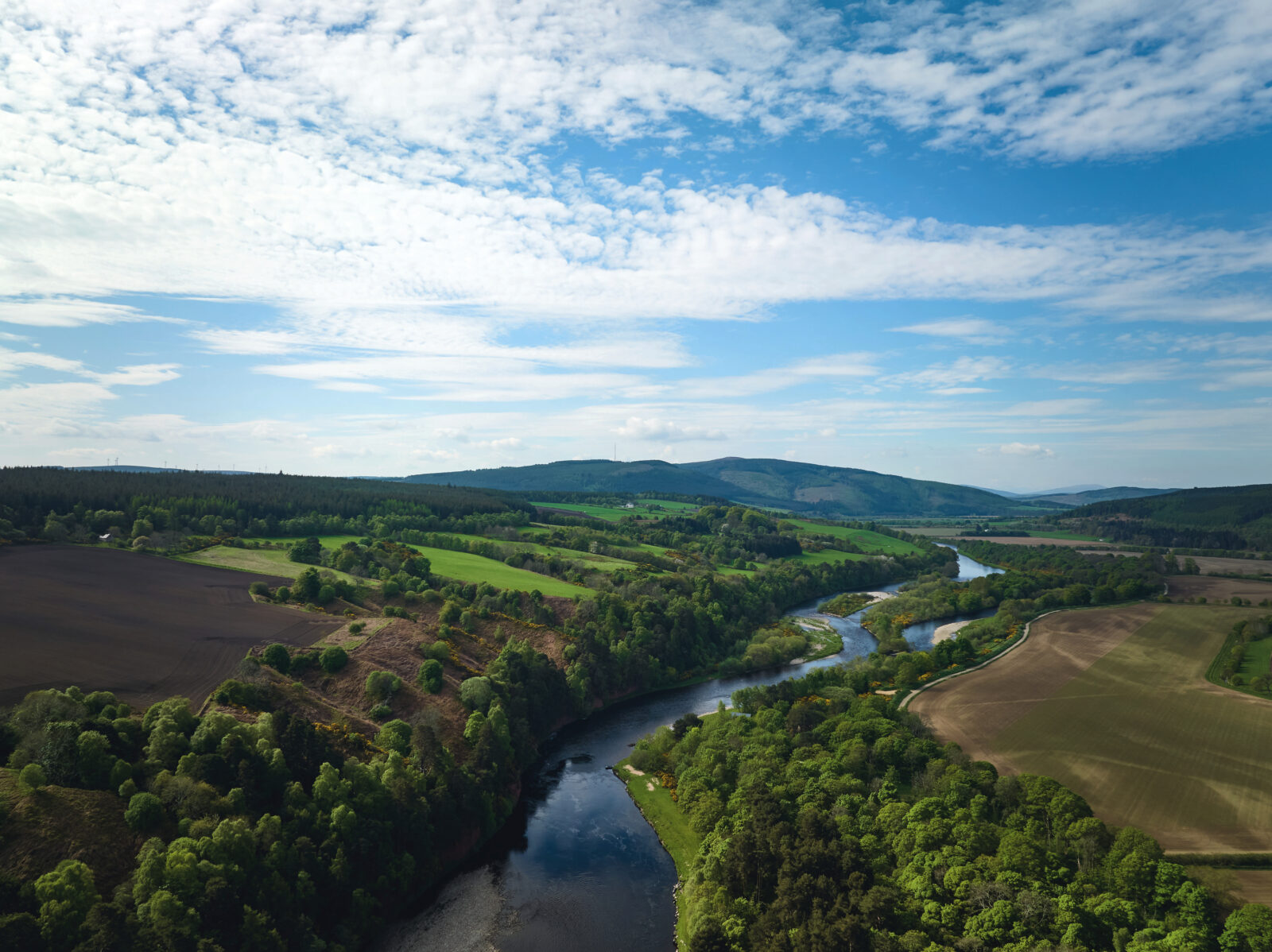
Photo: WILLIAM HEREFORD
A bird’s-eye view of the River Deveron.
The Deveron runs for sixty miles from open heather moorland to the North Sea near the town of Banff. For centuries it has ranked as one of the best sea trout and Atlantic salmon rivers in Scotland, hard on the heels of the Fabled Four—the Rivers Tay, Tweed, Dee, and Spey—and on October 21, 1924, it gave up the all-time U.K. record fly-caught Atlantic salmon, a heroic fish of sixty-one pounds, to a lady wonderfully named Clementina “Tiny” Morison.
The river and its tributaries have always held a good population of native brown trout as well, some of them reaching prodigious size (one of eleven pounds was caught recently on the Isla). With the steady, dispiriting decline of Atlantic salmon returns to U.K. waters, more attention is being brought to bear on the Deveron’s brown trout fishery, which very well may be one of the best in the British Isles. So it was heartening to learn that an organization called the Deveron, Bogie, and Isla Rivers Charitable Trust has been working to steward that fishery as well as the sea trout and salmon in the river.
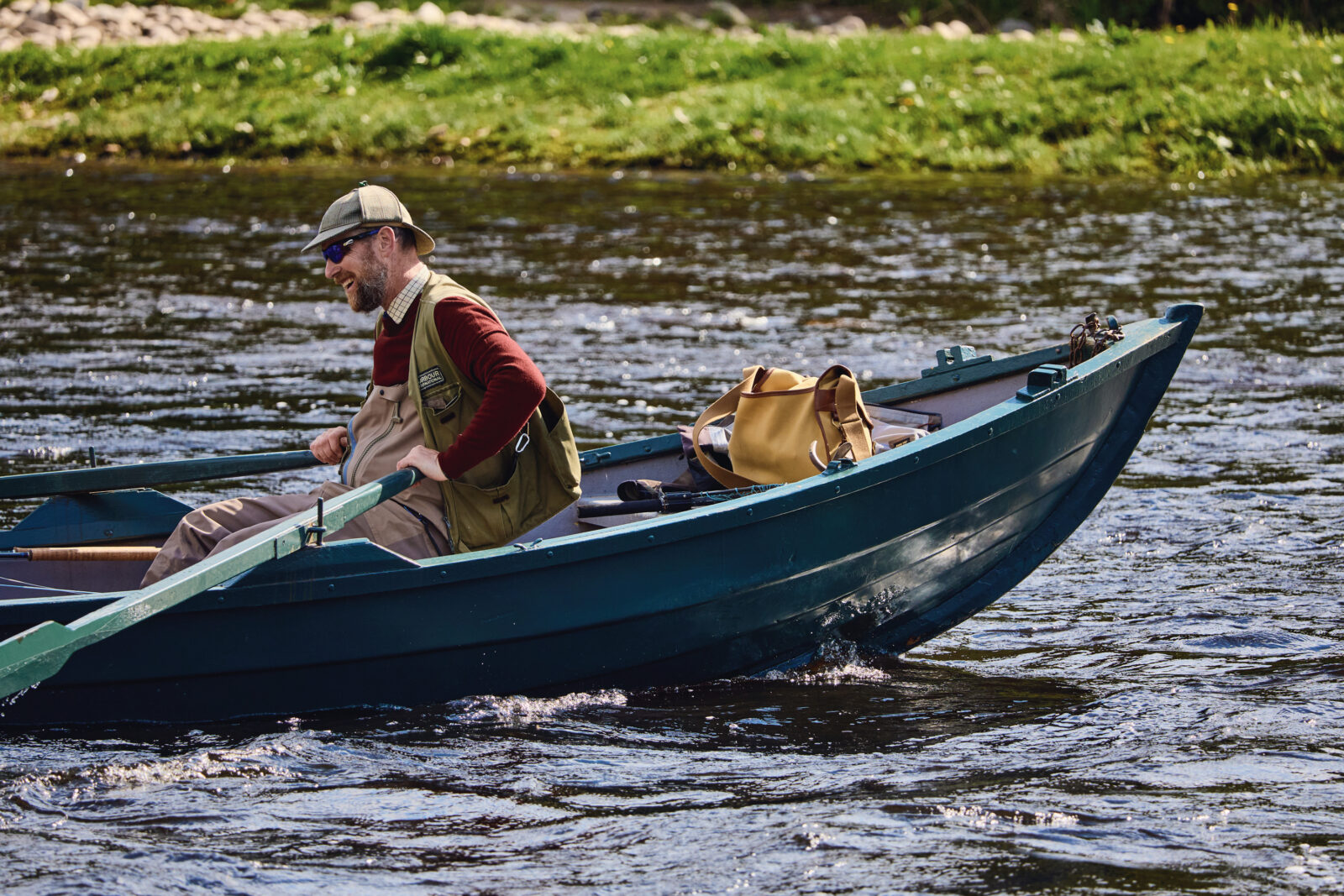
Photo: WILLIAM HEREFORD
A ghillie (guide) on the River Spey.
Under the leadership of a dedicated young man named Richie Miller and a staff of five, the Trust’s mission is to protect, increase, and sustain trout and salmon populations and habitat on the rivers in its name. Well funded by local landowners, private donations, and government money, the group mitigates flooding, opens old dams, installs fish ladders, controls invasive flora and fauna, and carries out extensive tagging and sonar-camera tracking programs for Atlantic salmon, whose numbers in Scottish rivers have plummeted by a stunning 75 percent in the last twenty-five years. When I asked Miller if he believed there was any way to turn that grim decline around, he toyed with his pen for a moment, then said, “We try to look at the glass half full.”
No one in our group fished for salmon in the Deveron, whose major run of that noble fish doesn’t take place until early fall, but we found the brown trout glass to be more than half full. Though there were few insect hatches while we were there and therefore few chances to fish dry flies to rising trout, and though our catches continued stubbornly through the week to measure between twelve and sixteen inches, we had plenty of those on nymphs and by swinging soft-hackle wet flies, a technique known as “fishing spiders” in Scotland and at which, in a tutorial he gave me, Paul Procter demonstrated a deadly mastery.
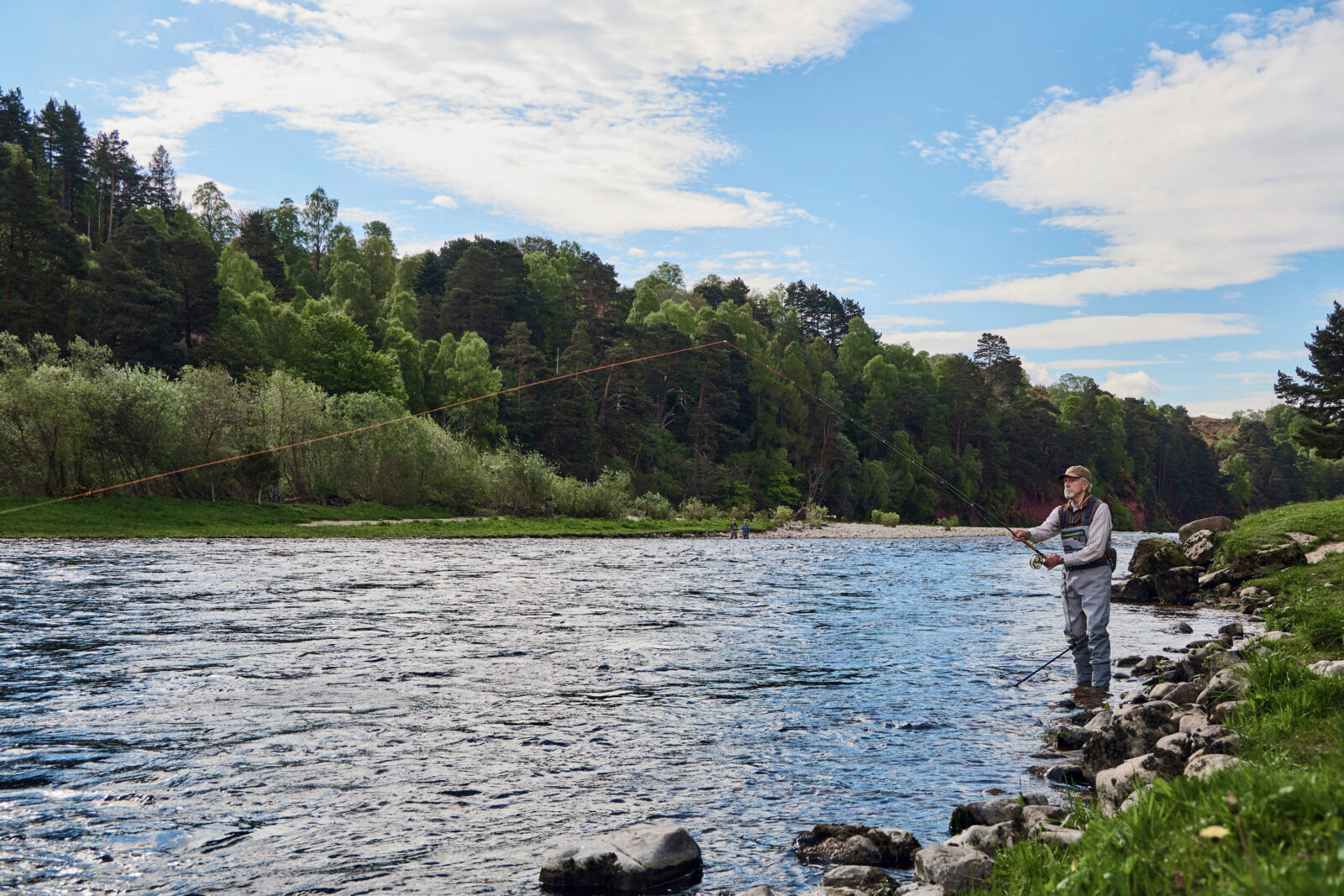
Photo: WILLIAM HEREFORD
The author fishing with a Spey rod on the River Spey.
As with wild brown trout fishing everywhere, success on the Deveron requires stealth and good presentations, and because tannin stains the water on its upper stretches to the color of Cuban coffee, the wading is tricky. But we found it to be a charming river to fish, with its slow, dark amble through green pastures, banksides of gorse and wild roses, and fetching configurations of pools and runs.

Photo: WILLIAM HEREFORD
A brown trout from the Deveron; the author with guide Paul Procter at Avochie Estate.
On the last day of fishing it without yet releasing a trout over fourteen inches, I decided to woo the river into compliance by singing to it a verse from a poem written by one John S. Rae in honor of the wedding of my new hero, Tiny Morison, in 1897. “Thy waters, O Deveron, run sparkling in glee,” I sang loudly, “and murmur a love song o’ sweet melody.”
Ridiculous, you say? I will let you know later how it worked out.
I like castles. I would not want to live in one (the upkeep!), but I do enjoy strolling around them and imagining what it would be like, say, to man the battlements with Robert the Bruce and pour boiling oil down on the invading English forces of Edward II.
Since the history of Scotland for the past sixteen centuries is one of almost uninterrupted invasions and wars, the country is littered with castle fortresses, and Aberdeenshire has one of the highest concentrations of them in the world. The touring itinerary Daniel had arranged for the nonanglers in our group included visits to a number of these, as well as gardens, Scotch whisky distilleries, and seaside villages, and I could not resist taking a couple of days off from the Deveron to join them.
In terms of upkeep, the spectrum of Scottish castles runs, I found, from a heap of fourth-century rubble in a field to, well… Balmoral. And it was at that top end where a few of us started. The hour-long drive from Avochie to the Scottish country residence of the British royal family passed for the first half of its length through a treeless arcadian landscape of gently undulating rectangles and trapezoids of just-greening barley fields, punctuated here and there by fields of canola in full, neon-yellow bloom as if they were slathered in Heinz mustard. On the hillsides ran hedges of gorse in their subtler yellow, and stone-wall-veined meadows flecked with sheep, like whitecaps on a green sea. As the route climbed into the Scottish Highlands, the air grew thinner and cooler, and the country became suddenly steep, gorge-y, and dense with birches, poplars, and evergreens, and then, on the entry road into Balmoral, with lordly and ancient Caledonian pines, some more than four hundred years old.
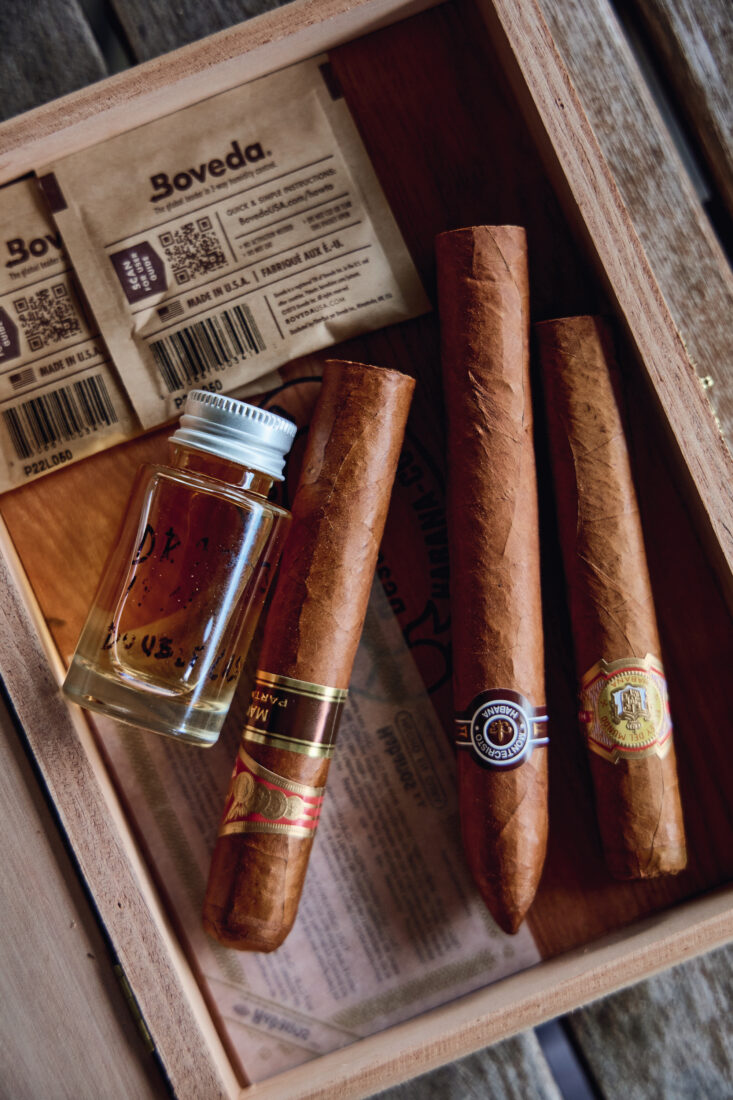
Photo: WILLIAM HEREFORD
Post-dinner cigars and a taste of very old Scotch in Avochie’s glass conservatory.
Except for late July through early October, when the royal family is in residence, the public is allowed to take a twenty-minute walk from a car park into the castle grounds, though the interior of Balmoral is off-limits except for a ground-floor ballroom. The walls at ceiling height in that ballroom are hung with hundreds of antlered heads of red stags shot on the castle’s 50,000 acres by various royals beginning with Prince Albert, a keen sportsman and husband to Queen Victoria. It was she who purchased the property in 1852 to afford the prince a place to hunt, shoot birds, and fish for salmon in the River Dee, which makes a stately flow inside the grounds. For the next three years, Victoria and Albert supervised the building of the castle, bought up as much adjoining land as they could, and began the refinements to the estate, which today includes 150 buildings, a vast kitchen garden and glass conservatory providing cut flowers for the royal household, a sunken topiary garden, stables, a cricket pitch, a deer larder, and a pet cemetery.
The castle itself is built of gray granite from the nearby Cairngorm Mountains, and despite its immensity and dour color, it seemed to me to be a bit languorous as castles go, in no way inviting the pouring of boiling oil from its four-turreted tower. Despite its context of rugged highlands countryside, the Dee valley landscape around the estate is as flawlessly composed as the late Queen Elizabeth II, who adored Balmoral. Just before departing, I looked out at the manicured walk beside the Dee and, in the defining image of my visit there, imagined Her Majesty striding along that path, dressed in tartan skirt and paisley headscarf, followed by her pack of corgis.
Of the three other castles I inspected, the first should be your immediate response if anyone ever says to you, “If you’ve seen one Scottish castle, you’ve seen them all.” “Sorry,” would be your offended reply, “but I have it on good authority that Dunnottar is sui generis.”
I visited Dunnottar the day after our trip to Balmoral, tagging along in the van with the nonanglers of our group and their guide, Malcolm Duckworth, a photographer who takes visitors on tours all over Scotland with voluble charm and encyclopedic knowledge of seemingly everything Scottish. On the forty-five-minute drive, Duckworth filled me in on local farming practices, the North Sea oil industry in Aberdeen, the pros and cons of Scottish independence, and Dunnottar’s bloody, convoluted history.
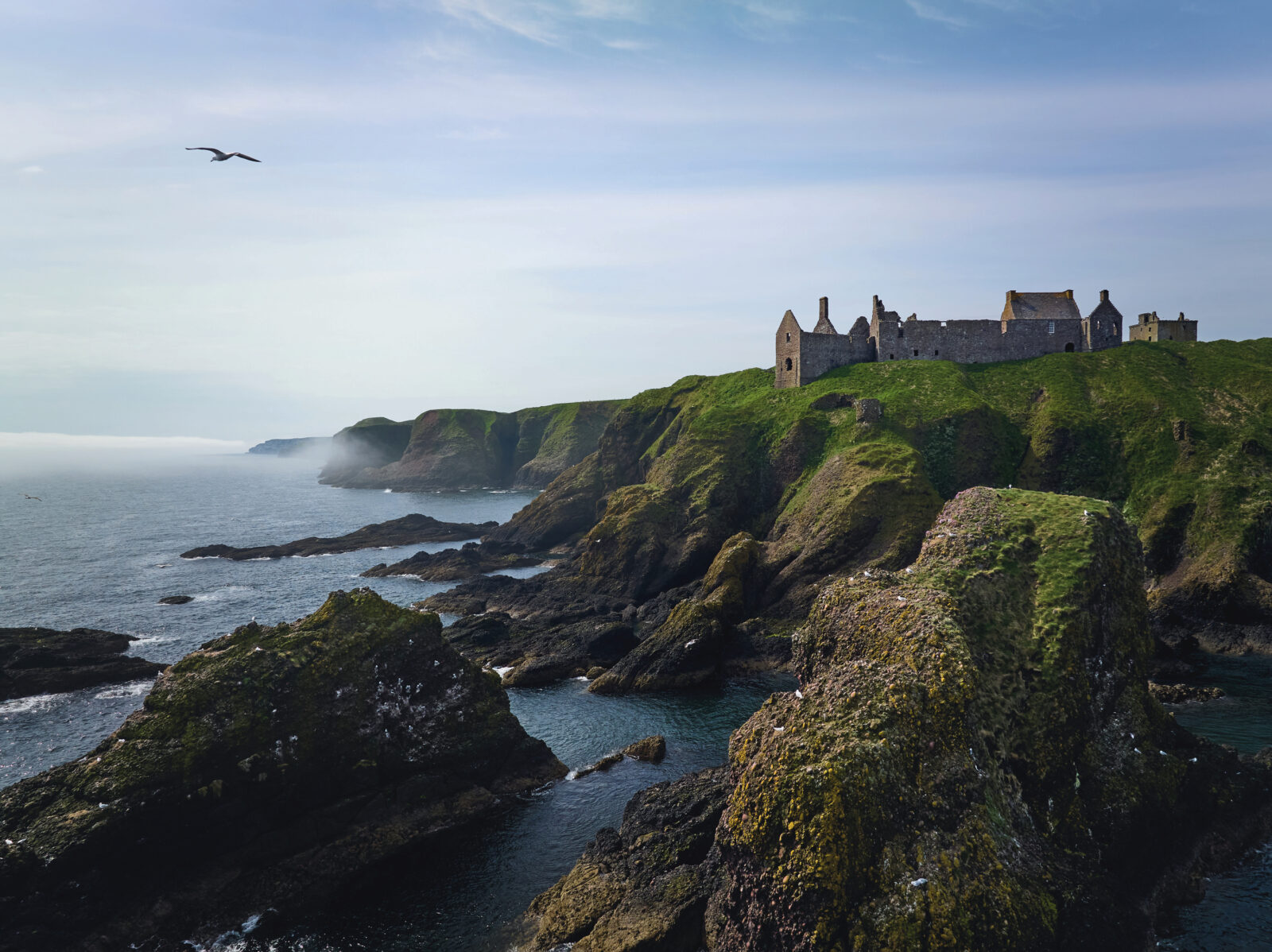
Photo: WILLIAM HEREFORD
The imposing Dunnottar Castle perches above the North Sea.
But no amount of information about it can prepare you for your first hair-raising view of Dunnottar Castle. To take that view, you stand at the edge of a vertiginous cliff overlooking the cold, pewter-gray North Sea. To your left, a winding trail of steps cuts into the cliff, leading down to the rocky shoreline, then continuing steeply upward to the massive stone pillar on which the castle and its outbuildings perch. The pillar rises 160 feet above the growling sea. All about it wheel gulls, razorbills, kestrels, and pigeons, and the fog drifts over it and then is whisked away again like a tattered coverlet. To put it mildly, the castle does not have a come-hither gleam in its eye: The very air around it seems to thrum with the foreboding that countless invaders must have felt on viewing it, and most visitors are happy to see all they want of Dunnottar from the mainland cliff. But for the full experience, you need to walk down and then back up the 266 steps to the top of the pillar and stand in Dunnottar’s grassy quadrangle. There, looming out of the fog, the castle’s keep, pends, storehouse, smithy, stables, and chapel surround you, all of this constructed (no doubt with unimaginable misery) between the thirteenth and sixteenth centuries out of a hard, unlovely conglomerate rock called pudding stone, which, along with its formidable site, gave Dunnottar the strongest natural defenses of any castle in Scotland. Stand there, pilgrim, and I defy you not to envision yourself pouring the hell out of boiling oil down onto the Picts or Saxons or Vikings or Celts or Jacobites who happened to be the invaders du jour.
By now you may forgivably have read all you want to read about Scottish castles. But I can’t leave the subject without briefly mentioning the last one I visited, which will circle us neatly back to fishing.
As a sort of lagniappe to the trip, Daniel had arranged for the three anglers in our party who had experience with double-handed Spey fly rods to fish a beat of the legendary river from which those rods take their name. The River Spey is to Atlantic salmon fishing what the Old Course at St Andrews is to golf, and we were delighted to have a kick at that hallowed can. We were doubly fortunate to do so on one of the best beats of the river, belonging to Gordon Castle.
The day, a particularly dulcet and vernal one, began in the village of Fochabers with the meeting of the ghillies, or guides, in the parking lot of the Gordon Arms Hotel. At more than a hundred miles, the Spey is one of Scotland’s longest rivers. All of its salmon water is privately owned, and visiting anglers can lease various stretches of that water, known as beats, by the day or week. Gordon Castle controls five-plus miles of double-bank fishing divided into four beats. Each of these fishes six rods and is assigned a ghillie, all of whom met us and the other Gordon Castle anglers of the day dressed in the traditional kit of neckties and estate tweeds. Our assigned beat was Upper Brae and our ghillie Ian Stronach, who has guided that beat exclusively six days a week for thirty-one years and knows every rock in its one-mile length.
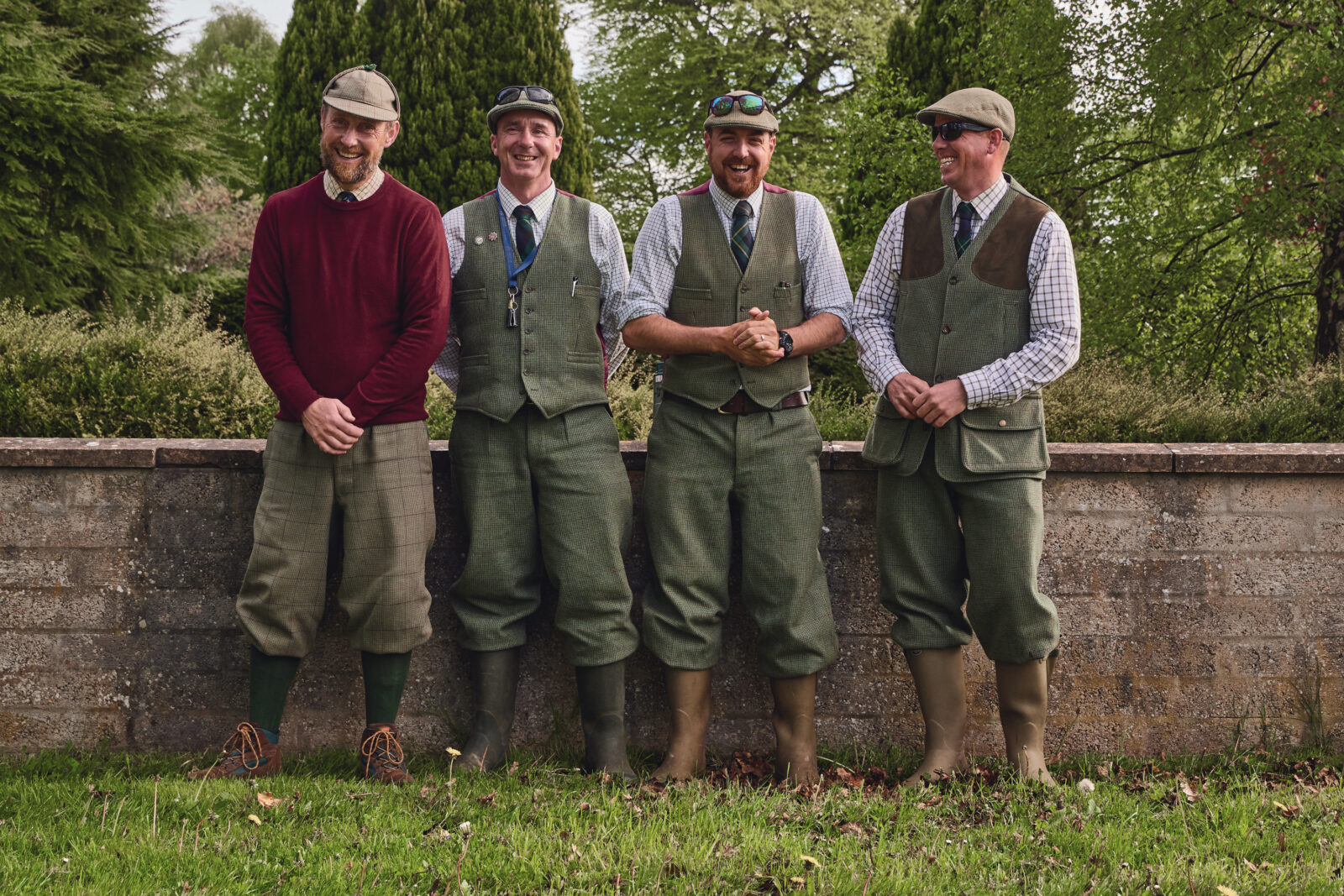
Photo: WILLIAM HEREFORD
Salmon ghillies dressed for a day of work on the Spey.
Though no one in our group that morning saw a salmon roll, let alone hooked one, my memory of our time on the Upper Brae stands among the sweetest in a long angling life. The sun was warm, the sky scumbled with high, thin clouds, the breeze light and cool. The Spey, full and dropping, gleamed in the morning sun, an eighty-yard-wide chuckling purl. With the long, effortless Spey rod, you roll out a hundred-foot cast down and across, drop the rod tip to the water against a straight line, and follow the fly to its dangle. Then you take three steps down in the knee-deep water and cast again, in the same timeless, mind-emptying rhythm of centuries of anglers before you, and the sky and sylvan riverscape press up against you as throbbingly alive as the flow against your legs.
During a fine lunch of Scotch eggs, crisps, and ale, taken in an equally fine old fishing hut midway down Upper Brae, Gordon Castle’s owner, Angus Gordon Lennox, came down to join us and, perfecting an already incomparable day, invited us to drive over that afternoon for a tour of the castle and gardens.
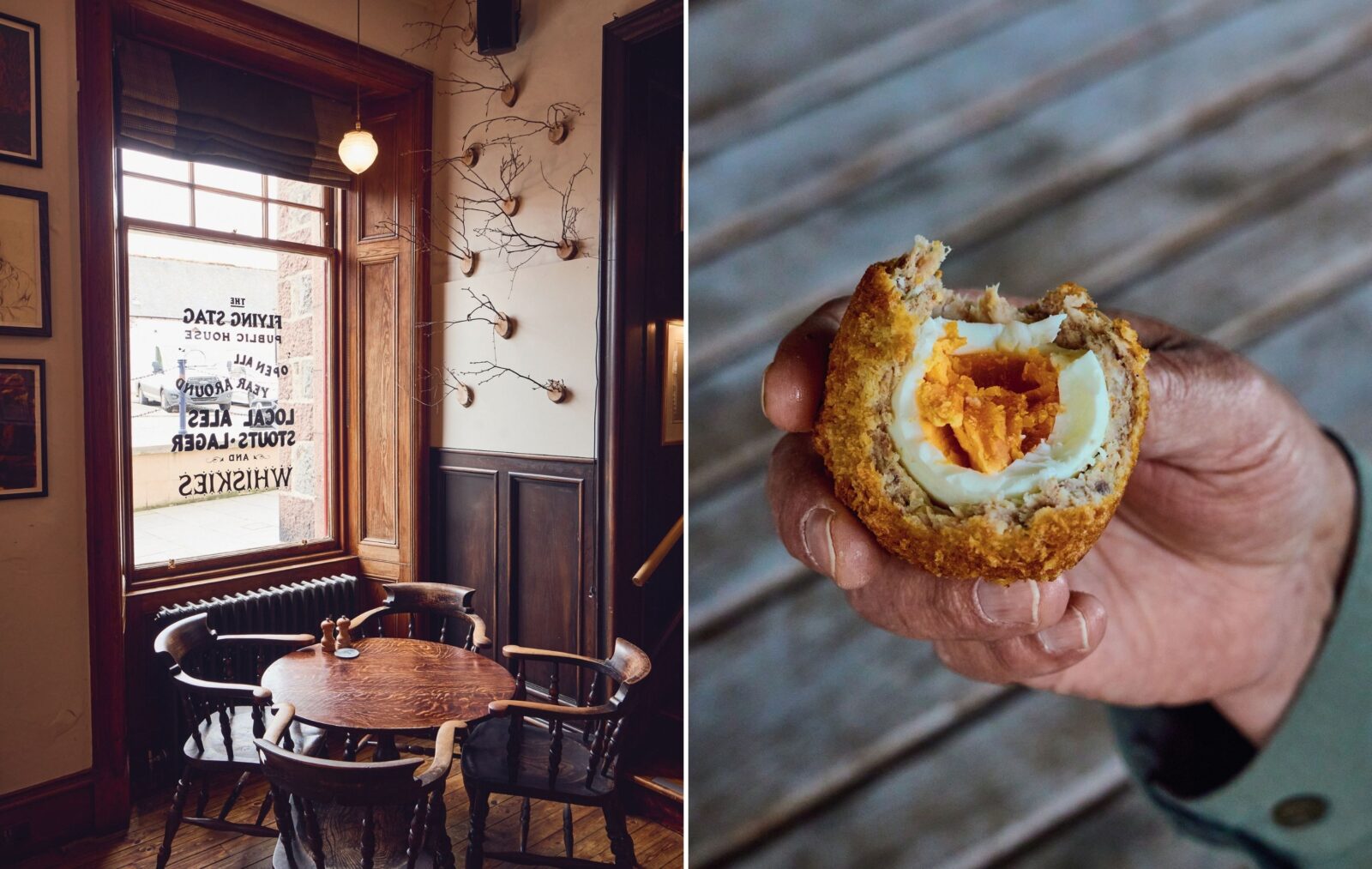
Photo: WILLIAM HEREFORD
A stop at the Flying Stag pub, in the Fife Arms Hotel in Braemar; a Scotch egg lunch during a day of fishing.
Unlike Balmoral and Dunnottar, Gordon is a castle earning its keep. Originally built as a boiling oil–type fortress in 1479 and owned down the centuries by various Gordons—one of Scotland’s oldest and most heralded clans—it is now run as a multifaceted business by Gordon Lennox and his wife, Zara. Surrounded by immaculate grounds and hayfields and approached down a long allée of old beech trees, the present iteration of the castle combines a handsome Downton Abbey–style manor house with a much older detached wing with a tower. Just down the road lies Gordon Castle’s walled garden. At eight acres, it is the largest productive walled garden in Scotland—a cornucopia of flowers, herbs, fruit, and vegetables, tended by Zara and four other full-time gardeners.
The garden sells its produce to the public, puts it on the menu at the Garden Café, and makes bath and beauty products from it to sell at the Garden Shop, along with castle-produced gin, ale, and cider. Some of the two thousand acres belonging to the estate are let to farmers; others support herds of red deer raised for the table; still others are given over to roe deer hunting and bird-shooting programs run by the castle along with its Spey fishing offerings. Lodging in the manor house sumptuously accommodates up to eighteen guests, with a large communal living room and a three-star chef to cater your meals. If it’s a wedding or anniversary you are after, the tower wing of the castle is available for special events and will seat up to 250 of your closest friends.
Angus Gordon Lennox is an energetic, enterprising man. The scion of an ancient, aristocratic lineage, son and grandson of generals, he has a jovial, impeccably mannered, military bearing. And he knows what he has in life. “Well,” he said at the end of our tour, “what do you think?”
“I think,” I said, “I know a group who might feel right at home here.”
Now about that song to the Deveron. It was the final day of the trip. What with all the castle-hopping and so forth I had not angled well all week, nor had I caught anything larger than toddler trout, and I admit to hoping for just a dollop of sauce to go with the last of the week’s splendid meal. My companions that day were William Daniel and the photographer William Hereford, who in late afternoon had gone upstream, leaving me with two undisturbed pools. Earlier, while Daniel and I took turns casting dry flies to infrequent rises without much success, I had asked him what he thought of trying a bizarre-looking imitation of a crane fly with which I had had success on the English chalk streams. “No, no,” he had said dismissively around his cigar. “Wrong time of year. Altogether wrong fly.”
Now, with less than an hour left to fish, having caught only a couple more sprats on a beetle fly and with no fish rising, I was about to lower my game to nymphing when I was struck with a double-bladed Scottish sword of inspiration. Tying on the maligned crane fly imitation, I channeled Tiny Morison and sang John S. Rae’s verse to the river. A large rock sat some forty feet upstream of me. The river coursed evenly down either side, forming a small eddy directly behind it—just the sort of place a good trout is likely to lie without strain, allowing the bifurcated current to deliver its dinner. It was a one-shot opportunity: a second or two for the floating fly to perch in the eddy before the current pulled it out, spooking any trout that might be there. With Tiny and John S. guiding my cast, I dropped the fly two inches from the base of the rock…and was rewarded at last with a true and bonny Deveron brown trout.
If You Go
For information on booking an angling stay on the River Deveron, or an angling, bird shooting, or deer stalking stay at Gordon Castle, William Daniel arranges tailored trips through his U.K.-based Famous Fishing. Contact him at william@famousfishing.co.uk.

